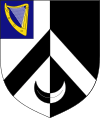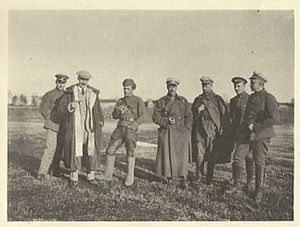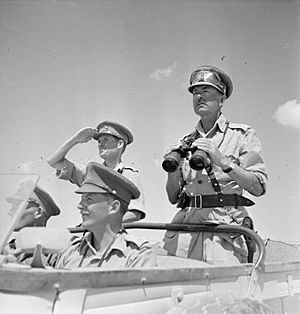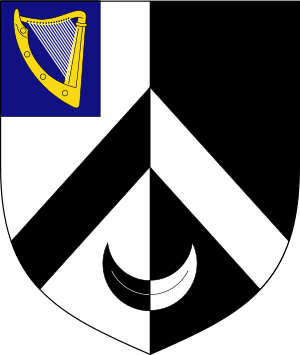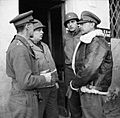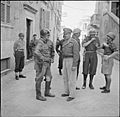Harold Alexander, 1st Earl Alexander of Tunis facts for kids
Quick facts for kids
The Earl Alexander of Tunis
|
|
|---|---|
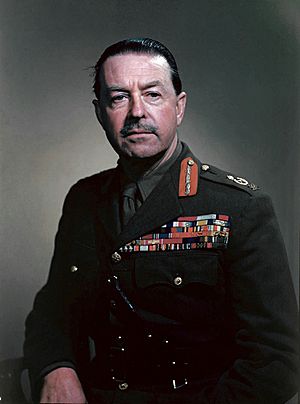 |
|
| 17th Governor General of Canada | |
| In office 12 April 1946 – 28 February 1952 |
|
| Monarch | |
| Prime Minister | |
| Preceded by | The Earl of Athlone |
| Succeeded by | Vincent Massey |
| Minister of Defence | |
| In office 1 March 1952 – 18 October 1954 |
|
| Prime Minister | Winston Churchill |
| Preceded by | Winston Churchill |
| Succeeded by | Harold Macmillan |
| Lord Lieutenant of London | |
| In office 25 April 1957 – 1 April 1965 |
|
| Monarch | Elizabeth II |
| Preceded by | Alan Brooke, 1st Viscount Alanbrooke |
| Succeeded by | Himself, as Lord-Lieutenant of Greater London |
| Lord-Lieutenant of Greater London | |
| In office 1 April 1965 – 28 December 1966 |
|
| Monarch | Elizabeth II |
| Preceded by | Himself, as Lord Lieutenant of the County of London |
| Succeeded by | Gerald Templer |
| Member of the House of Lords Lord Temporal |
|
| In office 1 March 1946 – 16 June 1969 Hereditary Peerage |
|
| Preceded by | Peerage created |
| Succeeded by | The 2nd Earl Alexander of Tunis |
| Personal details | |
| Born |
Harold Rupert Leofric George Alexander
10 December 1891 London, England |
| Died | 16 June 1969 (aged 77) Slough, Buckinghamshire, England |
| Spouse | Margaret Alexander, Countess Alexander of Tunis |
| Children |
|
| Alma mater | |
| Profession | Soldier |
| Signature |  |
| Military service | |
| Allegiance | United Kingdom |
| Branch/service | British Army |
| Years of service | 1911–1946 |
| Rank | Field Marshal |
| Unit | Irish Guards |
| Commands |
|
| Battles/wars |
|
| Awards | See below... |
Field Marshal Harold Rupert Leofric George Alexander, 1st Earl Alexander of Tunis (born 10 December 1891 – died 16 June 1969) was a very important British Army officer. He fought bravely in both the First World War and the Second World War. After his military career, he became the Governor General of Canada and later the first Lord Lieutenant of Greater London.
Alexander was born in London to a noble family. He went to Harrow School and then to the Royal Military Academy Sandhurst to train as an army officer. He became famous during the First World War, earning many awards. He continued to serve in various British campaigns across Europe and Asia. In the Second World War, he helped with the Dunkirk evacuation and led armies in Burma, North Africa, and Italy. He was even the Supreme Allied Commander in the Mediterranean.
In 1946, King George VI appointed him as Governor General of Canada. He served in this role until 1952. Alexander loved the Canadian outdoors and was very popular with Canadians. He was the last Governor General not born in Canada before Adrienne Clarkson. After his time in Canada, he became the British Minister of Defence under Winston Churchill. He retired in 1954 and passed away in 1969.
Contents
Early Life and Family Background
Harold Alexander was born in London into a noble family from County Tyrone, Northern Ireland. His family had roots in Scotland. He was the third son of James Alexander, 4th Earl of Caledon.
Alexander went to Hawtreys and Harrow School. He even played cricket in a famous match against Eton College in 1910. Although he thought about becoming an artist, he decided to join the army. He went to the Royal Military Academy Sandhurst to train as an officer.
Marriage and Children
Alexander married Lady Margaret Bingham on 14 October 1931. They had three children together and adopted a fourth:
- Lady Rose Maureen Alexander (born 1932, died 2017)
- Shane William Desmond Alexander, 2nd Earl Alexander of Tunis (born 1935)
- Brian James Alexander (born 1939)
- Lady Susan Mary Alexander (born 1948) (adopted)
Military Career: A Life of Service
In September 1911, Alexander joined the Royal Military Academy Sandhurst. He became a second lieutenant in the Irish Guards. By December 1912, he was promoted to lieutenant.
World War I: Early Heroism
Alexander spent most of the First World War fighting on the Western Front. In 1914, as a 22-year-old platoon leader, he served with the British Expeditionary Force (BEF). He was part of the retreat from Mons and was wounded at First Battle of Ypres. He was sent home to recover.
He was promoted to temporary captain in November 1914. He became a permanent captain in the 2nd Battalion the following year. Alexander returned to the Western Front in August 1915. He fought at the Battle of Loos. For his bravery there, he received the Military Cross in January 1916.
For his service in the Battle of the Somme in September 1916, he received the Distinguished Service Order (DSO). The award recognized his courage in leading attacks and holding ground. In the same month, he was honored with the French Légion d'honneur.
On his 25th birthday, 10 December 1916, Alexander became second-in-command of the 1st Battalion, Irish Guards. He was an acting major. By May 1917, he was briefly acting as the commanding officer of the 1st Battalion. He was still a captain at this time. He became a permanent major in August 1917. In October, he was confirmed as the commanding officer of the 2nd Battalion, Irish Guards.
Alexander led his battalion at Third Ypres, where he was slightly wounded. He also fought at Bourlon Wood during the Battle of Cambrai. His battalion suffered heavy losses there. From March 23 to 30, 1918, Alexander commanded the 4th Guards Brigade. This was during the British retreat from the German Army's Spring Offensive. He again commanded the 2nd Battalion, Irish Guards, at Hazebrouck in April 1918. The battalion took such heavy casualties that it could not fight further.
Rudyard Kipling, a famous writer, wrote about the Irish Guards. He noted that Alexander was very good at leading his men. Kipling said that Alexander's subordinates loved him, even when he was tough on them. His men were very loyal to him.
Between the Wars: Rising Through the Ranks
In 1919, Alexander served with the Allied Control Commission in Poland. He led the Baltic German Landeswehr in the Latvian War of Independence. He helped forces loyal to Latvia push out the Bolsheviks. He was accidentally wounded during this time.
Alexander returned to Britain in May 1920. He was promoted to lieutenant-colonel in May 1922 and became commanding officer of the 1st Battalion, Irish Guards. He commanded the battalion in Constantinople, Gibraltar, and London. In February 1928, he was promoted to colonel. He then commanded the Irish Guards Regimental District. He also led the 140th (4th London) Infantry Brigade until January 1930.
He then held staff jobs. In October 1934, he became a temporary brigadier. He was given command of the Nowshera Brigade in India. For his service there, he was made a Companion of the Order of the Star of India. He was also mentioned in dispatches for his actions against the Pathans. He was mentioned again for his service during the Second Mohmand Campaign. Alexander was known for leading from the front, often reaching mountain tops with his troops.
In March 1937, Alexander became an aide-de-camp to King George VI. He returned to the UK for the King's coronation. After the coronation, he went back to India. He became the honorary colonel of the 3rd Battalion, 2nd Punjab Regiment. In October 1937, he was promoted to major-general. This made him the youngest general in the British Army. In June 1938, he was appointed a Companion of the Order of the Bath.
World War II: Leading Allied Forces
When the Second World War began in September 1939, Alexander took the 1st Division to France. It became part of the British Expeditionary Force (BEF). In May 1940, when the German Army invaded France, he successfully led his division's retreat to Dunkirk. They were then evacuated to England. Alexander was put in command of I Corps at Dunkirk. He was the last British officer to leave the eastern mole on June 2, after making sure all British troops were evacuated. He was again mentioned in despatches for his service.
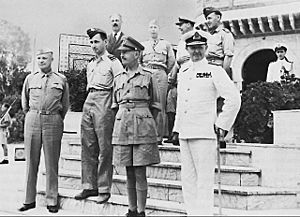
After Dunkirk, Alexander returned to the UK. He continued to command I Corps, guarding the coasts. He was promoted to acting lieutenant-general in July 1940. He became the General Officer Commanding-in-Chief (GOC-in-C) of Southern Command. This command was responsible for defending south-west England. His rank of lieutenant-general became permanent in December 1940.
On 1 January 1942, he was knighted. In February, after the Japanese invasion of Burma, he was sent to India. He became the GOC-in-C of British Forces in Burma. Alexander could not hold Rangoon, which was abandoned in March. He took charge of some small battles and was surrounded by Japanese troops. Chinese troops rescued him. Alexander then let his corps commander, Lieutenant-General William Slim, handle most of the fighting. Alexander focused on working with the Chinese forces' commander, Joseph Stilwell. Alexander was promoted to Commander-in-Chief (C-in-C) of Allied Land Forces in Burma in March 1942. He ordered Slim to retreat to India.
By July 1942, British and Indian forces had retreated into India. Alexander was called back to the UK. He was then sent to Cairo in August to replace General Claude Auchinleck as C-in-C of Middle East Command. This role was for the campaign in North Africa. Lieutenant-General Montgomery replaced Auchinleck as GOC of the British Eighth Army. Alexander oversaw Montgomery's victory at the Second Battle of El Alamein. He also oversaw the Eighth Army's advance to Tripoli. For this, Alexander was made a Knight Grand Cross of the Order of the Bath.
In February 1943, the Anglo-American forces from Operation Torch and the Eighth Army met in Tunisia. They were put under Alexander's command in the new 18th Army Group. This group reported to General Dwight D. Eisenhower, the Supreme Allied Commander. The Axis forces in Tunisia surrendered by May 1943. Alexander's command became the 15th Army Group. This group was responsible for the Allied invasion of Sicily in July. Alexander controlled two armies: General Montgomery's Eighth Army and Lieutenant General George S. Patton's U.S. Seventh Army.
After Sicily, the U.S. Seventh Army was replaced by the U.S. Fifth Army, led by Lieutenant General Mark W. Clark. This was in preparation for the Allied invasion of Italy.
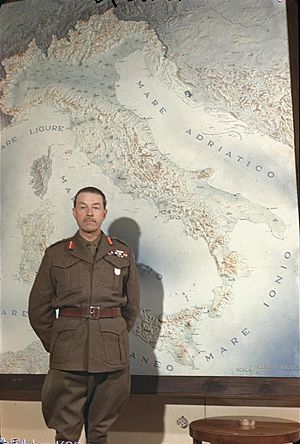
Alexander remained in command of the 15th Army Group and later the Allied Armies in Italy (AAI). He led them through most of the Italian Campaign. He approved the controversial bombing of the historic abbey at Monte Cassino. The German defenses, called the Winter Line, were very strong. It took four attempts for the Allies to break through. Alexander's forces then captured Rome in June 1944. This was a major goal of the Italian Campaign.
In December 1944, Alexander became the Supreme Commander of the Allied Forces Headquarters. This meant he was in charge of all military operations in the Mediterranean Theatre. He was promoted to field marshal. This promotion was backdated to June 4, 1944, so he would be senior to Montgomery. Alexander accepted the German surrender in Italy on 29 April 1945. As a reward for his leadership, he was made a peer by King George VI. He became Viscount Alexander of Tunis on 1 March 1946.
Governor General of Canada: A New Role
After the war, Alexander was considered for a top military job in Britain. However, Canadian prime minister William Lyon Mackenzie King asked him to become the Governor General of Canada. Alexander chose to retire from the army and take this new position. He was appointed Knight Grand Cross of the Order of Saint Michael and Saint George and created Viscount Alexander of Tunis. He was sworn in during a ceremony in the Senate chamber on 12 April 1946.
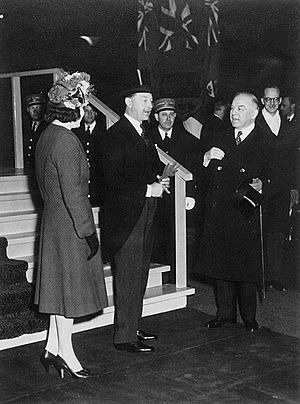
Alexander took his duties as viceroy very seriously. He felt he connected Canadians with their King. He traveled extensively across Canada, covering over 294,500 km (184,000 mi) in five years. On these trips, he met with Canadians at various events. He was very interested in his role as Chief Scout of Canada. He even practiced kicking the opening ball for the 1946 Grey Cup final.
In 1946, he was named the first non-Indigenous chief of the Kwakiutl tribe. He received a totem pole on 13 July 1946, which is still at Rideau Hall today. By the end of the year, Alexander was also made a Knight of the Order of the Garter.
In 1947, the King allowed the Canadian governor general to use all the monarch's powers for Canada. In 1949, it was decided to call non-British member states of the Commonwealth of Nations "members of the Commonwealth" instead of "Dominion". That same year, Alexander oversaw Newfoundland joining Canadian Confederation. He toured the new province that summer. Later, in Alberta, he was made Chief Eagle Head of the Blackfoot tribe.
By 1950, Canada was involved in the Korean War. Alexander, as acting commander-in-chief, sent soldiers, sailors, and airmen to the conflict. He visited them before they left.

The Viscount traveled abroad for official visits. He met US president Harry S. Truman in 1947. He also hosted many important guests at Rideau Hall. The Alexanders lived a relatively informal lifestyle at Rideau Hall. They even hosted a square dance in the palace's ballroom for Princess Elizabeth and the Duke of Edinburgh.
Alexander enjoyed painting and had a studio at Rideau Hall. He also played many sports, including golf, ice hockey, and rugby. He loved the outdoors, especially during the maple syrup harvest. He even oversaw the process on Rideau Hall's grounds. He presented the Alexander Cup to the Canadian Amateur Hockey Association in 1950. This cup became the championship trophy for senior ice hockey.
Canadians generally liked Alexander as their viceroy. He had a great military reputation and was charismatic. He could easily connect with people.
Later Life and Legacy
Lord Alexander left his role as Governor General of Canada in early 1952. Winston Churchill asked him to return to London to become Minister of Defence. Soon after, King George VI died. Alexander quietly left for the UK, respecting the King's mourning.
After returning to the UK, Alexander was given a higher noble title by the new queen. On 14 March 1952, he became Earl Alexander of Tunis. He served as the British defence minister until 1954. Then, he retired from politics. In 1959, Queen Elizabeth II appointed him to the Order of Merit. From 1960 to 1965, he was the Constable of the Tower of London. Alexander was also an active freemason.
Canada remained a favorite place for the Alexanders, and they visited often. Alexander passed away on 16 June 1969. His funeral was held at St. George's Chapel in Windsor Castle. He is buried in the churchyard of Ridge, near his family's home.
Awards and Recognitions
Ribbon bars of the Earl Alexander of Tunis
Appointments
- 7 February 1936 – 16 June 1969: Companion of the Order of the Star of India (CSI)
- 1938 – 1 January 1942: Companion of the Most Honourable Order of the Bath (CB)
- 1 January 1942 – 11 November 1942: Knight Commander of the Most Honourable Order of the Bath (KCB)
- 11 November 1942 – 16 June 1969: Knight Grand Cross of the Most Honourable Order of the Bath (GCB)
- 1 January 1946 – 16 June 1969: Knight of the Most Venerable Order of the Hospital of Saint John of Jerusalem (KStJ)
- 16 September 1946 – 28 February 1952: Knight of Justice, Prior, and Chief Officer in Canada of the Venerable Order of Saint John of Jerusalem (KStJ)
- 20 January 1946 – 25 March 1960: Knight Grand Cross of the Most Distinguished Order of Saint Michael and Saint George (GCMG)
- 25 March 1960 – 12 October 1967: Grand Master of the Most Distinguished Order of Saint Michael and Saint George
- 12 October 1967 – 16 June 1969: Knight Grand Cross of the Most Distinguished Order of Saint Michael and Saint George (GCMG)
- 12 April 1946 – 28 February 1952: Chief Scout of Canada
- 13 July 1946 – 16 June 1969: Honorary Chief of the Kwakiutl Tribe
- 3 December 1946 – 16 June 1969: Knight of the Most Noble Order of the Garter (KG)
- 1950 – 16 June 1969: Chief of the Blackfoot Tribe
- 29 January 1952 – 16 June 1969: Member of the King's Privy Council for Canada (PC (Can))
- 17 May 1957 – 1 April 1965: Lord Lieutenant of the County of London
- 1 April 1965 – 28 December 1966: Lord Lieutenant of Greater London
- 1960–1965: Constable of the Tower of London
- 1 January 1959 – 16 June 1969: Member of the Order of Merit (OM)
Decorations
 14 January 1916: Military Cross (MC)
14 January 1916: Military Cross (MC) 20 October 1916: Companion of the Distinguished Service Order (DSO)
20 October 1916: Companion of the Distinguished Service Order (DSO) 7 June 1951: Canadian Forces Decoration (CD)
7 June 1951: Canadian Forces Decoration (CD)
Medals
 1919: 1914 Star with clasp
1919: 1914 Star with clasp 1919: British War Medal
1919: British War Medal 1919: Victory Medal
1919: Victory Medal 1935: King George V Silver Jubilee Medal
1935: King George V Silver Jubilee Medal 1935: India General Service Medal (1909)
1935: India General Service Medal (1909)- 1937: King George VI Coronation Medal
 1945: 1939–45 Star
1945: 1939–45 Star 1945: Burma Star
1945: Burma Star 1945: Africa Star
1945: Africa Star 1945: Italy Star
1945: Italy Star 1945: War Medal 1939–1945
1945: War Medal 1939–1945- 1953: Queen Elizabeth II Coronation Medal
Awards
 4 January 1917: Mentioned in Despatches
4 January 1917: Mentioned in Despatches 27 December 1918: Mentioned in Despatches
27 December 1918: Mentioned in Despatches 8 July 1919: Mentioned in Despatches
8 July 1919: Mentioned in Despatches 3 February 1920: Mentioned in Despatches
3 February 1920: Mentioned in Despatches 7 February 1936: Mentioned in Despatches
7 February 1936: Mentioned in Despatches 8 May 1936: Mentioned in Despatches
8 May 1936: Mentioned in Despatches 20 December 1940: Mentioned in Despatches
20 December 1940: Mentioned in Despatches 28 October 1942: Mentioned in Despatches
28 October 1942: Mentioned in Despatches 1945 Freedom of the City of Manchester
1945 Freedom of the City of Manchester 25 March 1946 Freedom of the City of London
25 March 1946 Freedom of the City of London Freedom of the City of Edinburgh
Freedom of the City of Edinburgh
Foreign Honours and Decorations
 20 October 1916: Knight of the Légion d'honneur
20 October 1916: Knight of the Légion d'honneur : Member Second Class with Swords of the Order of St. Anna
: Member Second Class with Swords of the Order of St. Anna 10 August 1943: Chief Commander of the Legion of Merit
10 August 1943: Chief Commander of the Legion of Merit 29 February 1944: Member First Class of the Order of Suvorov
29 February 1944: Member First Class of the Order of Suvorov 20 June 1944: Member Grand Cross of the Royal Order of George I
20 June 1944: Member Grand Cross of the Royal Order of George I 5 December 1944: Member Fifth Class of the Order Virtuti Militari
5 December 1944: Member Fifth Class of the Order Virtuti Militari 2 August 1945: Distinguished Service Medal
2 August 1945: Distinguished Service Medal
Honorary Military Appointments
 7 March 1936 – 19 November 1937: Aide-de-Camp to His Majesty the King (ADC)
7 March 1936 – 19 November 1937: Aide-de-Camp to His Majesty the King (ADC) 2 July 1937 – 14 August 1947: Colonel of the 3rd Battalion 2nd Punjab Regiment
2 July 1937 – 14 August 1947: Colonel of the 3rd Battalion 2nd Punjab Regiment 20 July 1944 – 2 August 1946: Aide-de-Camp General to His Majesty the King (ADC General)
20 July 1944 – 2 August 1946: Aide-de-Camp General to His Majesty the King (ADC General) 28 August 1946 – 16 June 1969: Colonel of the Irish Guards
28 August 1946 – 16 June 1969: Colonel of the Irish Guards 10 November 1949 – n/a: Colonel of the Royal Ulster Rifles (London Irish Rifles)
10 November 1949 – n/a: Colonel of the Royal Ulster Rifles (London Irish Rifles) 10 July 1951 – n/a: Colonel of the Oxford University Contingent of the University Training Corps
10 July 1951 – n/a: Colonel of the Oxford University Contingent of the University Training Corps
Honorary Degrees
- 22 May 1946: McGill University, Quebec Doctor of Laws (LLD)
- 1946: Queen's University, Ontario Doctor of Laws (LLD)
- 1946: University of Toronto, Ontario Doctor of Laws (LLD)
- 13 May 1948: University of British Columbia, Doctor of Laws (LLD)
- 21 March 1949: University of California Los Angeles, Doctor of Laws (LLD)
- 22 October 1949: University of Western Ontario, Doctor of Laws (LLD)
- 1953: University of Liverpool, Doctor of Laws (LLD)
- 1955: University of Nottingham, Doctor of Laws (LLD)
Unofficial Titles
- Chief Eagle Head
Honorific Eponyms
Geographic Locations
Schools
Coat of Arms
Images for kids
-
Major-General The Hon. Harold Alexander with King George VI inspecting men of the 2nd Battalion, Hampshire Regiment, part of the 1st Infantry Brigade (Guards) of Alexander's 1st Division, near Bachy, France, December 1939.
-
General Sir Harold Alexander with Major General Lucian Truscott and other senior Allied commanders at Anzio, Italy, 5 May 1944. Major-General John Hawkesworth is pictured on the far right wearing a parachutist helmet, and to the left of him is Major-General Philip Gregson-Ellis.
See also
 In Spanish: Harold Alexander para niños
In Spanish: Harold Alexander para niños


